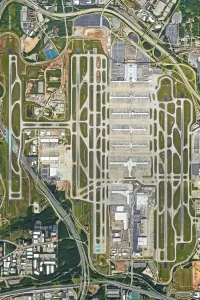
Atlanta Prosperity Located in Atlanta, you will be deeply attracted by the prosperity of the city. As a world-renowned aviation hub, Atlanta’s airport not only connects the world, but also witnesses the rise and prosperity of the city. Here, you can feel the pulse of the modern city and appreciate the intersection of global business and culture. In every corner of Atlanta, there is a lot of vitality and opportunities waiting for you to explore and discover. The world’s busiest airport The brilliant achievements of the airport appreciate the bustling urban scenery of Atlanta, and we further focus on the brilliant achievements of Atlanta Airport. Atlanta Hartsfield-Jackson International Airport, referred to as Atlanta Airport, is not only the largest and busiest airport in the world, but also hosts many well-known airlines. Both Delta Air Lines and Trans Airways operate from this airport as a hub, connecting routes around the world. In addition, Atlanta Airport is also a sister airport with Shanghai Airport, and is jointly committed to improving hub operations, flight punctuality and high-tech applications. As a 24-hour airport, Atlanta Airport attracts passengers from all over the world with its convenient flight network and efficient operation model. In 2006, Atlanta Airport was the busiest airport in the world with more than 80 million passengers and 970,000 flights. According to a report by Airports Council International, in 2010, Atlanta Airport’s airline customer passenger traffic reached 89.30 million, an increase of 1.5% from 2009, far exceeding the second-largest airport, Beijing 15 million passengers. The history of the airport The birth and development of Atlanta Hartsfield-Jackson International Airport can be described as a magnificent history. Originating from an abandoned car track, the lease was signed by then-Mayor Walter Sims in 1925, marking the birth of Candler Field, the predecessor of Atlanta Airport. The land was named Candler Field after Coca-Cola tycoon and former Atlanta Mayor Asa Candler in honor of its historical contribution. On September 15, 1926, the first aircraft took off from Jacksonville. After several years of development, Pitcairn Airlines and Delta Airlines began to serve Atlanta. With the opening of Candler Field’s first control tower and the United States government’s declaration of it as an Air Force base, the airport rapidly expanded during World War II, with a record 1,700 takeoffs and landings in a single day, making it the busiest airport in the country. Hartsfield-Jackson International Airport Details The Birth and Development of the Airport In 1946, Candler Field was renamed Atlanta City Airport and gradually developed into an important transportation hub. In 1948, it welcomed 1 million passengers, demonstrating its strong passenger capacity. In 1956, Eastern Airlines opened flights to Montreal, Canada, marking the birth of the first international departure flight from Atlanta’s Hartsfield-Jackson International Airport. From a small local airport to a global aviation hub, Atlanta has attracted a large number of domestic passengers and a strong demand for transfers. Airport Expansion and Modernization In January 1977, under the leadership of Mayor Maynard Jackson, the central end point of Atlanta Hartsfield-Jackson International Airport was rebuilt and expanded. This huge project not only ensured the modernization needs of the airport, but also carried the historical mission of urban development. On September 21, 1980, the new airport opened as scheduled, without exceeding the budget by a penny. Entering the new century, the airport management has proposed a “future-focused” construction plan to improve the airport’s facilities and provide more convenient services for arriving and departing passengers. Airport Facilities and Services Terminals and Transportation Systems Hartsfield-Jackson Airport occupies a vast area and ranks third in the world. As the main base of Delta Air Lines, the airport undertakes major air traffic tasks and its international route network covers the world. There are two main terminals in the airport – the North Terminal and the South Terminal, which are closely connected by huge conjoined buildings. Passengers can easily move between various halls through the advanced transportation system and enjoy a comfortable travel experience. The underground rail transit system “peoplemover” connects various passenger halls, effectively improving the travel efficiency of passengers. At the same time, the system is also connected to urban public transportation, providing passengers and residents with a more efficient and comfortable travel experience.
发表回复